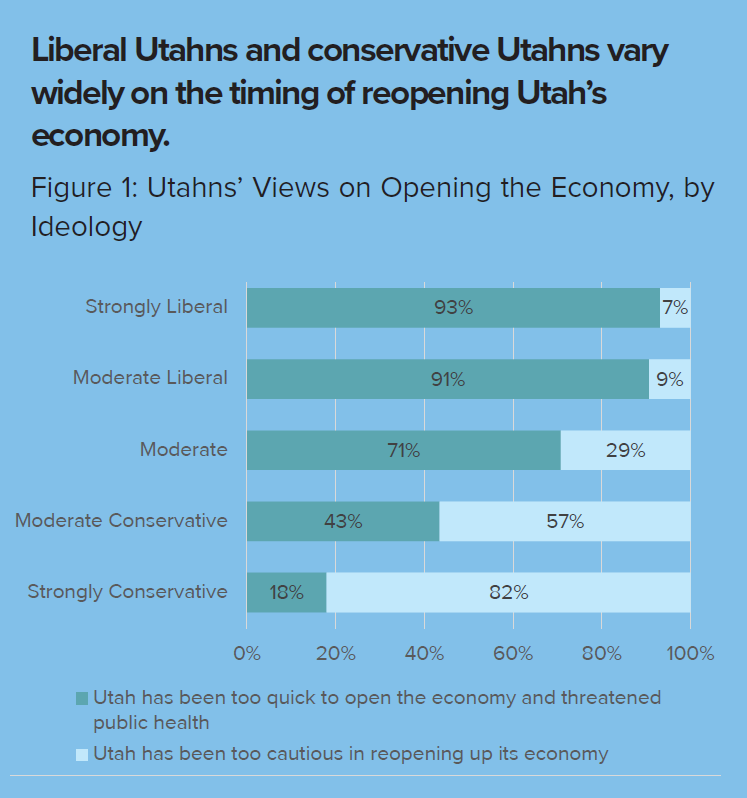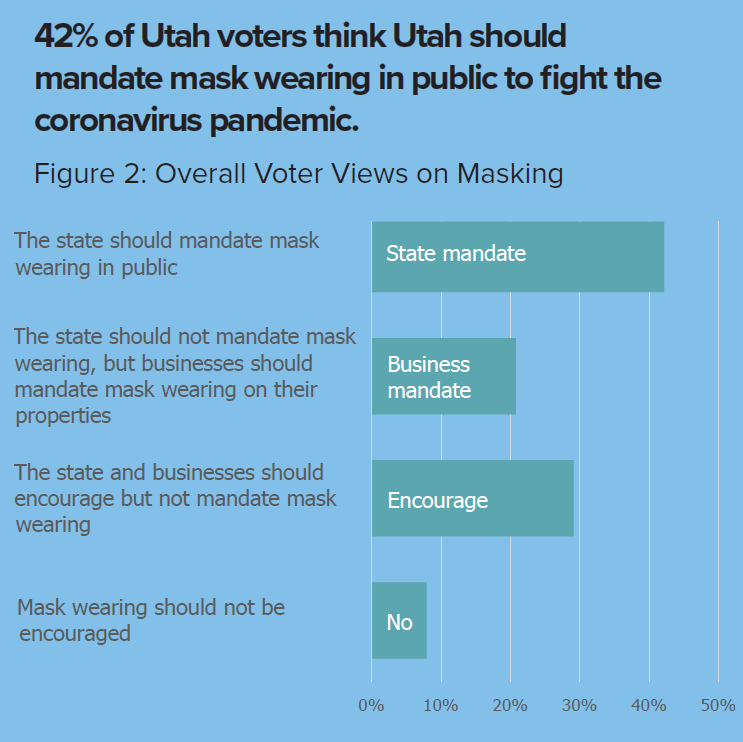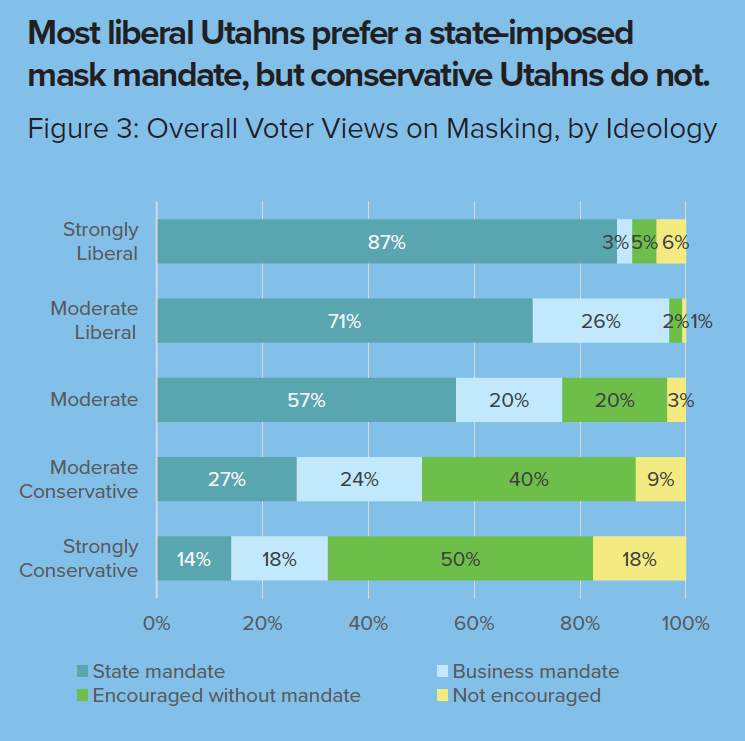When Utah Foundation surveyed voters in an open-ended poll about their top concerns during winter 2020, the spread of the novel coronavirus had barely been a concern, and did not make the Utah Priorities Project list of top issues. However, by the summer, the coronavirus pandemic ended up as the 5th biggest concern, and drove the major concerns around the top four priorities.
Public health / COVID-19 pandemic was the top issue for more than 25% of respondents in the survey – the most commonly selected top priority. Among the other three-quarters of voters it was equally likely to end up in 3rd, 9th or 15th place.
Demographic Differences
Public health / COVID-19 pandemic is certainly an important issue in Utahns’ minds; it was a top-five issue for all demographic groups analyzed except for those who have lived in the state for between 21 and 40 years, and people with less than a bachelor’s degree.
It is interesting to note that public health / COVID-19 pandemic is the top issue for men, but not for women. Women concentrated their concerns on the top four pandemic-related issues. Members of the Silent Generation were the most concerned of any generational group about public health / COVID-19 pandemic. This is unsurprising given that they are 75 and over, and the coronavirus poses a particular danger to their demographic.
Infections in Utah
Utah’s coronavirus case counts grew rapidly beginning early June. However, case counts appeared to stabilize and even decrease in late July and August, but then took a turn for the worse by September with record high rates.
Salt Lake County continues to be the county with the most cases – and a high case rate.1 Within the county, cases have been concentrated on the northwestern portion. This has played a role in the disproportionate percentage of infections among the state’s Hispanic/Latino population. Despite being just 14% of Utah’s total population, Hispanic/Latino residents accounted for 32% of cases by late September.2 This may be due in part to the fact that Hispanic/Latino households are slightly larger than average (3.5 compared to 3) and that they are likely to have jobs that can not be performed remotely.3
Neighboring Summit, Utah and Wasatch counties also have high case rates. Utah County even surpassed Salt Lake County’s 14-day case count in late September – though the former has just over half the population of Salt Lake County. In Utah County, cases are concentrated in the downtown Provo and Orem areas.
Parts of San Juan County on the southeast corner of the state have had far-and-away the highest rate at more than 6,000 cases per 100,000 residents. Its rate seems to have stabilized through the summer.
The overall death rate of the pandemic sits at 6.3 per 1,000 Utah cases – for a total of more than 450 Utahns by late September.4 The mortality rate of the coronavirus has decreased over time due in part to a deeper understanding of the virus and better protocols for treating patients, as well as well as more quickly and correctly identifying who has the virus.
Did the state re-open the economy too quickly or slowly? It depends on whom you ask.
In April, Utah’s governor issued an advisory to stay at home when possible and Salt Lake County issued a public health order that limited permissible economic activity. Many of these restrictions had been lifted by the time the second survey was administered.
The Utah Priorities Project found that 56% of voters thought that the state was too quick in reopening its economy, while 44% thought it was too cautious in reopening. The differences by ideology are stark. More than 9 in 10 liberals thought the state was too quick, while most conservatives thought the opposite. (See Figure 1.) Moderates, however, lean much closer to the liberal point of view; 71% thought the state was too quick.
The Question of a Mask Mandate
With respect to mask wearing, the Utah Priorities
Project found that 42% of voters thought the state should mandate mask wearing in public, while another 21% felt that, instead of the state, businesses should mandate mask wearing on their properties. (See Figure 2.) Another 29% of voters preferred encouragement over mandates. A small minority of Utahns were not even interested in encouragement. (See Utah Foundation’s August 6,
2020, Significant Statistics blog post for more details.5) Similarly, a Hinckley Institute survey from late July 2020 found that 43% of Utahns thought that the governor should implement a mask mandate.6
Again, this question depends on whom you ask. Liberal voters were much more interested in a state mandate while conservative voters were much more interested in encouragement without a mandate. (See Figure 3.)
Of the Americans who do not wear masks, 40% say it is “their right as an American to not wear a mask” and another 24% say “because it is uncomfortable.”7 (Smaller numbers say they do not have access to a mask, they do not want to be mistaken for a criminal or they think the coronavirus is a conspiracy.) For those who do wear masks, 60% say they want to “protect themselves and others,” 19% want to “protect themselves,” and 12% want to “protect others.” The remaining 9% wear them because “it is the law.”
National Views
The proportion of Americans “very” concerned about COVID-19 infections rose rapidly throughout March from 18% to 32%.8 Since then, the rates have remained relatively constant with those “very” worried fluctuating between a high of 39%, a low of 28%, and by late September at 32%. Another third of the nation is somewhat concerned.
In contrast, Americans “very” worried about the economy rose to 64% by the end of March. It dropped to 55% starting April 1 and has remained fairly stable, at 53% in late September. Another third of the nation is somewhat worried.
Endnotes
- ^Utah Department of Health, COVID-19 Surveillance, https://coronavirus.utah.gov/case-counts/.
- ^Ibid.
- ^Utah Foundation, Significant Statistics | One group of Utahns is more likely to contract – but also survive – the coronavirus,
June 19, 2020, www.utahfoundation.org/2020/06/significant-statistics-one-group-of-utahns-is-more-likely-to-contract-butalso-
survive-the-coronavirus/. - ^Utah Department of Health, Ibid.
- ^Utah Foundation, Significant Statistics | How Utahns View the National Masquerade, August 5, 2020, www.utahfoundation.
org/2020/08/significant-statistic-how-utahns-view-the-national-masquerade/. - ^Deseret News, Poll finds 43% of Utahns want Herbert to issue statewide mask mandate, August 5, 2020, www.
deseret.com/utah/2020/8/5/21355939/poll-hinckley-gary-herbert-mask-mandate-approval-job-performance-covid-19-
coronavirus. - ^Brookings, American individualism is an obstacle to wider mask wearing in the US, August 31, 2020, www.brookings.edu/
blog/up-front/2020/08/31/american-individualism-is-an-obstacle-to-wider-mask-wearing-in-the-us/. - ^FiveThirtyEight, How Americans View The Coronavirus Crisis And Trump’s Response, updated September 30, 2020,
https://projects.fivethirtyeight.com/coronavirus-polls/.




